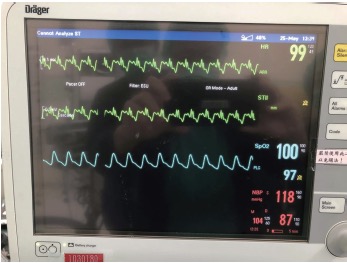To the Editor,
Although remifentanil is a potent, short-acting synthetic opioid analgesic, it exerts unfavorable side effects, such as bradycardia, muscle rigidity, and hyperalgesia.1 We experienced a case of intermittent right bundle branch block (RBBB) during hemorrhoidectomy with monitored anesthesia care under continuous remifentanil infusion.
A 45-year-old man (height, 164 cm; weight, 91 kg) was diagnosed with bloody stool and mixed hemorrhoids and scheduled for colonoscopy and hemorrhoidectomy. He was relatively robust prior to this episode and had no family history of cardiovascular events. He was placed in the left lateral decubitus position before colonoscopy, and midazolam (2.5 mg) and a continuous target-controlled remifentanil infusion, starting at 3.0 ng/mL according to the Minto model, was administered to maintain the Observer Assessment of Alertness/Sedation Scale (OAA/S) at 3–4. The remifentanil was tapered to 1.5 ng/mL because of a drop in systolic blood pressure from 110 to 90 mmHg 5 min after induction. The patient tolerated the colonoscopy smoothly and was changed to the prone position for the hemorrhoidectomy. To prevent incisional pain and further anxiety, we adjusted remifentanil from 1.5 to 3.0 ng/mL and administered an extra 1 mg of midazolam to maintain the patient’s OAA/S at 3–4. Meanwhile, 2% lidocaine with 1:200,000 epinephrine was injected into the planned surgical fi eld. Twenty minutes after the skin incision, electrocardiography revealed the sudden onset of RBBB (Fig. 1), but no massive bleeding or unexpected surgical stress was noted. The heart rate was elevated from 80 to 100 beats/min, and the systolic blood pressure remained stable (± 115 mmHg). The patient did not complain of discomfort, and the OAA/S was 4. The first episode of RBBB was approximately 20 s, and normal sinus rhythm resumed without further medication. Because this phenomenon occurred intermittently in the following 10 min, with the OAA/S maintained at 4, we tapered the remifentanil from 3.0 to 1.5 ng/mL. Thereafter, the RBBB disappeared. Postoperatively, the patient recovered smoothly from sedation without any complications, and RBBB did not reoccur.

Download full-size image
RBBB occurs when normal electrical activity in the His–Purkinje system is interrupted and usually indicates structural heart disease, chronic obstructive lung disease, cor-pulmonale, cardiomyopathy, or previous cardiac surgery.2 Although remifentanil exerts vagomimetic effect,3 Shirasaka et al. described that remifentanil transiently increased mean arterial pressure, heart rate, and those parameters mediated by sympathetic nerve activation in conscious rats.4 Fujii et al. found that remifentanil might inhibit intra-atrial conduction and sinus node automaticity, but it had no effect on atrioventricular node conduction, and dose-dependency was not observed within the range of 0.2–0.4 μg/kg/min.5 Our patient’s preoperative electrocardiogram was normal, except for a slight widening of the QRS complex without ST-segment change. Because the RBBB disappeared when the remifentanil dosage was reduced, there could be a possible association, although the dosage fell within the acceptable range (0.2–0.4 μg/kg/min).
In conclusion, anesthesiologists must bear in mind that remifentanil infusion may induce transient RBBB, and dosage adjustment should be closely followed up.
References
| 1 |
Komatsu R, Turan AM, Orhan-Sungur M, McGuire J, Radke OC, Apfel CC.
Remifentanil for general anaesthesia: a systematic review.
Anaesthesia 2007;62:1266–1280.
|
| 2 |
Horowitz LN, Alexander JA, Edmunds LH Jr.
Postoperative right bundle branch block: identification of three levels of block.
Circulation 1980;62:319–328.
|
| 3 |
Shinohara K, Aono H, Unruh GK, Kindscher JD, Goto H.
Suppressive effects of remifentanil on hemodynamics in baro-denervated rabbits.
Can J Anaesth 2000;47:361–366.
|
| 4 |
Shirasaka T, Yano T, Kunitake T, Tsuneyoshi I.
High-dose remifentanil increases blood pressure and heart rate mediated by sympatho-activation in conscious rats.
J Anesth 2013;27:325–332.
|
| 5 |
Fujii K, Iranami H, Nakamura Y, Hatano Y.
High-dose remifentanil suppresses sinoatrial conduction and sinus node automaticity in pediatric patients under propofol-based anesthesia.
Anesth Analg 2011;112:1169–1173.
|